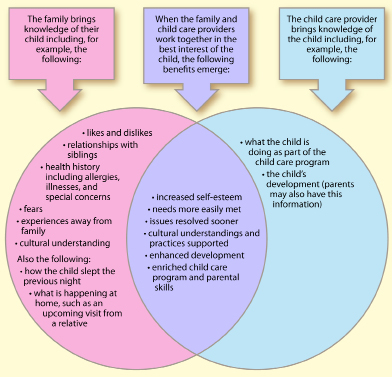Session 1
1. Session 1
1.2. Inquiry 1
Session 1: Together with Families
Inquiry 1: Families Are Important

Comstock/Thinkstock
Families have a significant influence on children’s lives.
Families come in many forms. Families are people who form a common household. Some families have one parent while others have two parents; some families are blended (the result of two families coming together); some families are extended (they include aunts, uncles, or grandparents, for example); some families are traditional or nuclear (they are made up of two parents and the children they had together). In any family, the parent may be a birth mother or father, an adopted mother or father, a person appointed as a guardian, or a foster parent.
When thinking about families, it is important to remember the following:
- Families have a significant influence on children’s lives.
- Family members try to do what is best for their children with the energy and resources they have.
- Adults, when in an atmosphere of trust and acceptance, try to change if they realize change would be best for their children.
- Everyone is affected by changes in the family, such as a new baby, a grandparent coming to stay, parents separating, and so on.
- Parenting skills are developed in a variety of ways, including the following:
- from common sense
- from the parent’s experiences within a family and other experiences
- from outside sources, such as books, courses, television, newspapers, magazines, and so on
- The self-esteem of the child is closely related to the self-esteem of the parents or other significant family members.
For information about working with families, watch the video clip “Together with Families.”
Child Care Provider–Family Relationships
The family has the greatest influence on a child’s life. For children in care, the child care experience affects the child as well. It is in the best interest of the child when family members and child care providers work together as partners. Each brings something special to the relationship.
Benefits of Positive Family and Child Care Provider Relationships

Potential Barriers to Building and Maintaining Positive Family–Child Care Provider Relationships

Jupiterimages/Goodshoot/Thinkstock
Everyone benefits when there is a positive relationship between families and child care providers. Unfortunately, this doesn’t always happen. Sometimes barriers can get in the way of positive relationships. Some of these barriers could be the following:
- Attitudes—Sometimes parents think that child care providers have an easy job. These parents don’t seem to value the hard work, effort, and thoughtfulness of child care providers. Sometimes, even when parents do appreciate the child care providers, they forget to express their appreciation. On the other hand, sometimes child care providers think parents don’t care enough about the children and believe parents use the child care facility as a place to “dump” their child.
- Different Values and Beliefs—Parents and child care providers may have different values and beliefs about children and parenting. These may arise from their childhood and adult experiences, as well as from their cultural understandings. For additional information about cultural understandings, see Session 2: Respecting Cultural Diversity.
- Different Priorities—Each parent wants the best for her or his child, and child care providers must be equally concerned about all the children in their care. Sometimes it may seem parents want special considerations for their child, and this can cause misunderstandings between child care providers and parents. For example, the child care facility may have a policy that children are only permitted to eat at designated times, whereas a parent may live by a philosophy that children should eat when they are hungry.
- Unclear Policies—Sometimes parents are not aware of, or are unclear about, the policies and requirements of child care programs. As a child care provider, it is critical that you check the parents’ understanding of the policies and discuss them when necessary. A parent handbook outlining the facility’s policies should be readily available for reference by child care providers and parents.
Do you know where to access a copy of the parent handbook at the child care facility where you have been working or volunteering? Ask for a copy so that you can read through the handbook. As you read the policies, try to think about them from a parent’s perspective as well as from a child care provider’s perspective.
The Role of the Child Care Provider in Developing Relationships with Families

© emin kuliyev/shutterstock
It is important for child care providers to acknowledge that barriers can exist. Child care providers need to take the initiative to break down these barriers and establish positive relationships with families.
Consider the following child care provider practices that encourage relationships with families:
- Practice 1: Examine your attitudes. Have you made assumptions about certain families without having the whole picture? Are you quick to apply blame to families rather than trying to understand challenges they face?
- Practice 2: Appreciate that there are many different ways to raise children and many different kinds of families. A child care provider’s job is not to judge, but to offer excellent care for children and, whenever possible, support for families.
- Practice 3: Let families know that their children are very important and that every child receives quality care.
- Practice 4: Show families that you are genuinely interested in their children. Notice things about each child
(for example, “Johnny was so excited about the trip to the zoo on the weekend!”).
- Practice 5: Share with families something special about the child’s day.
- Practice 6: Actively listen to family members’ concerns and opinions.
- Practice 7: Work together with families to find mutually acceptable solutions to problems.
- Practice 8: Be warm and friendly toward families. Show an interest in family members as individuals
(for example, “How are things going at your new job?”).
- Practice 9: Be sensitive and open to learning about cultural differences. Always try to learn about cultural understandings and practices from the family members. Do not rely on generalizations or stereotypes.
- Practice 10: Make sure that parents receive and understand the policies of the child care program. (Remember that it may be that not all family members read English—if necessary, find people in the community to translate.)
Reflection: Think about experiences you have had in the child care facility. How have you or other child care providers reduced barriers with families?
To gather more ideas on how barriers with families can be reduced, you may wish to discuss this reflection with a peer from your class or with child care providers working in the child care facility.